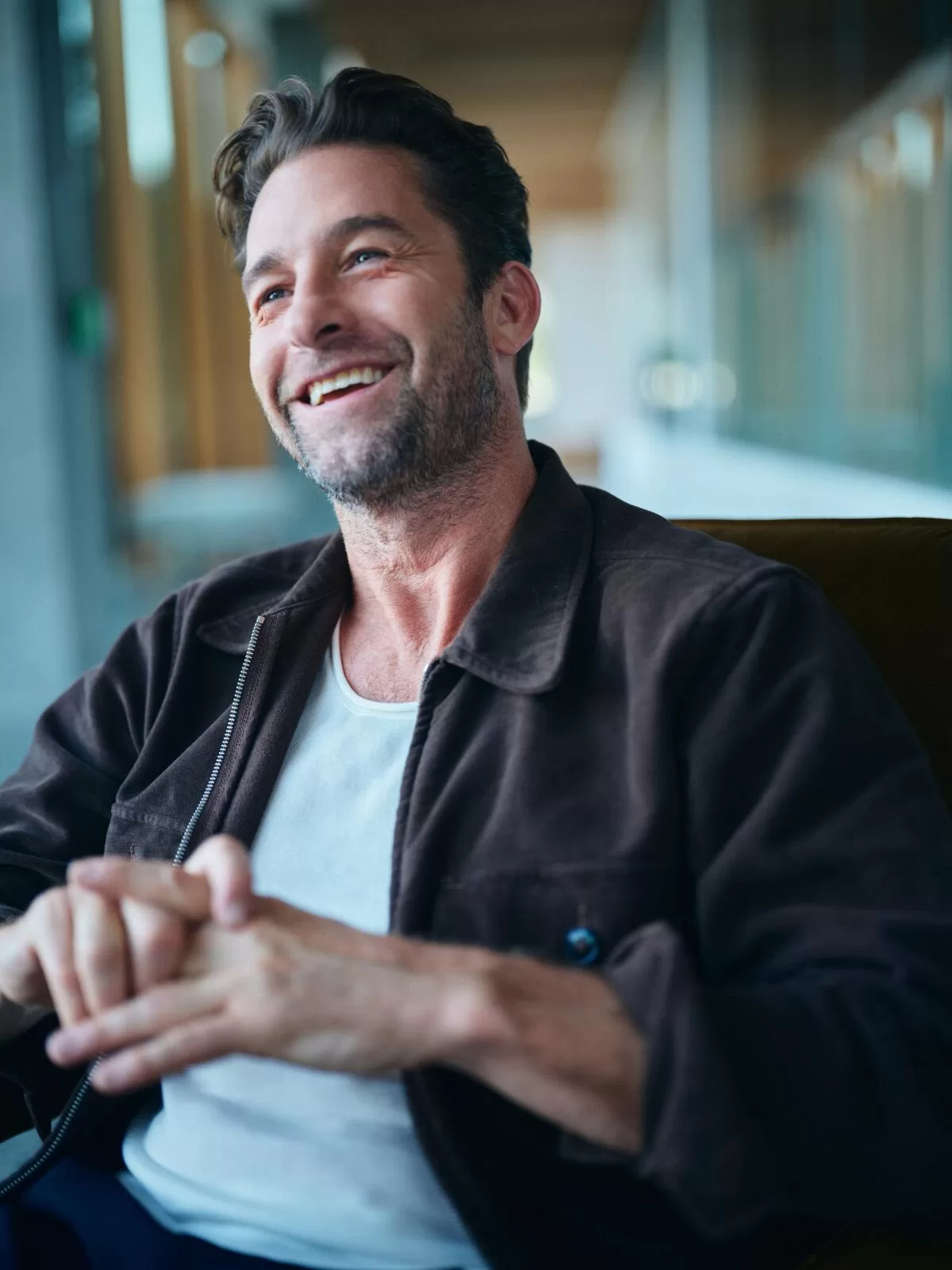Welcome to Screen Gab, the newsletter for everyone who wants to make “Saturday Night Live” weird again.
As Screen Gab editor Matt Brennan and staff writer Meredith Blake note in this week’s Break Down, that’s just one lesson the venerable sketch comedy series could draw from its very first episode, which recently inspired the feature film Saturday night.
Also in our 153rd edition, the director of “Casa Bonita Mi Amor!” discusses his new documentary about the creators of “South Park” reviving the beloved Denver-area Mexican joint, plus streaming recommendations for your weekend.
Newsletter
You are reading Screen Gab newsletter
Sign up to get recommendations for the TV shows and streaming movies you can’t miss, plus exclusive interviews with the talent behind your favorite titles, in your inbox every Friday
You may occasionally receive promotional content from the Los Angeles Times.
ICYMI
Must-read stories you might have missed

Scott Speedman.
(Marcus Ubungen / Los Angeles Times)
For Scott Speedman, ‘Felicity’ fame was a ‘culture shock.’ Now it works to his benefit: On “Grey’s Anatomy” and Peacock’s new sci-fi thriller “Teacup,” the actor keeps stretching himself — in part by playing off fan expectations of a former WB heartthrob.
What to know about ‘Agatha All Along’s’ Billy Maximoff: Here’s his backstory: “Agatha All Along” has finally revealed who Teen was all along. Here’s Billy Maximoff’s backstory and the questions that remain for Episode 6 and beyond.
Jessica Williams is ready for the unexpected, even on the 405 Freeway: The actor reflects on living in L.A., her love of ceramics and her starring role in Apple TV+’s “Shrinking,” now in its second season — while battling traffic.
Franchises took over reality TV. Now they threaten its success: Like the Marvel Cinematic Universe or scripted series with countless spinoffs, reality TV has become more reliant on proven franchises as the industry becomes more risk-averse.
Turn on
Recommendations from the film and TV experts at The Times
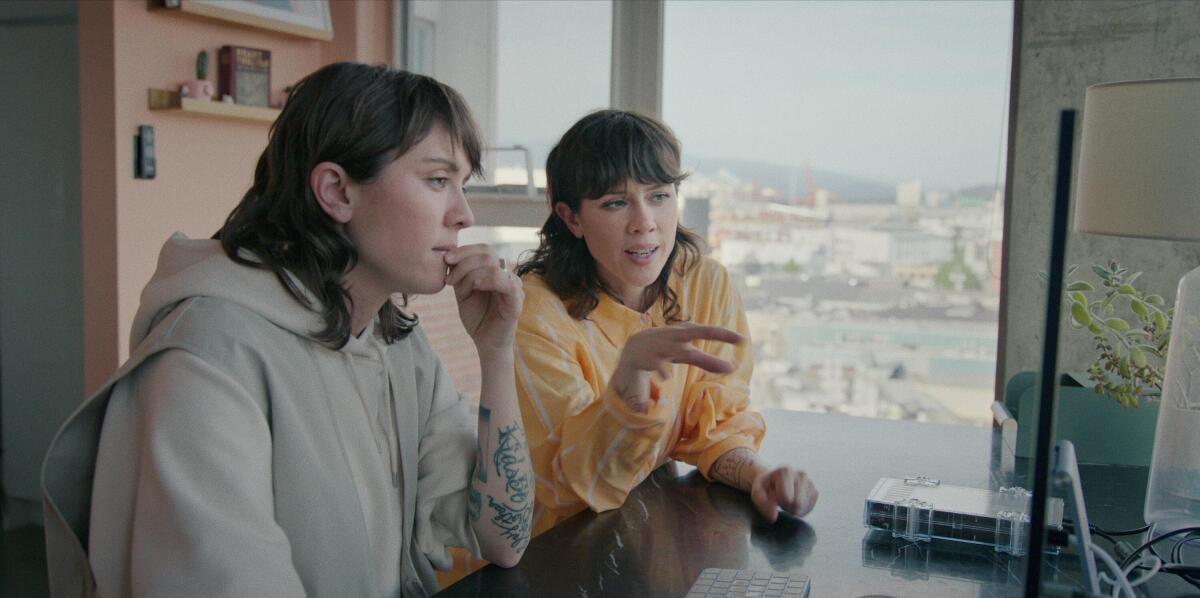
Tegan and Sara Quin in “Fanatical: The Catfishing of Tegan and Sara.”
(Disney)
Fanatical: The Catfishing of Tegan and Sara (Hulu)
Erin Lee Carr’s documentary does tell the story of how identical twins Tegan and Sara Quin rose to fame as a queer indie-pop music group, in part through the direct connections they made with their fans, often on social media. But the film also tells a parallel story that happened out of view of their public-facing one, in which, over a span of many years, someone posed as Tegan online and lured numerous unwitting fans into emotionally fraught relationships. A front row seat to the dark side of contemporary standom, the film becomes a gripping online detective story as the sisters, their management and even the fans who were misled all try to unravel the identity and motives of the person they come to refer to as “Fegan,” for fake Tegan. —Mark Olsen
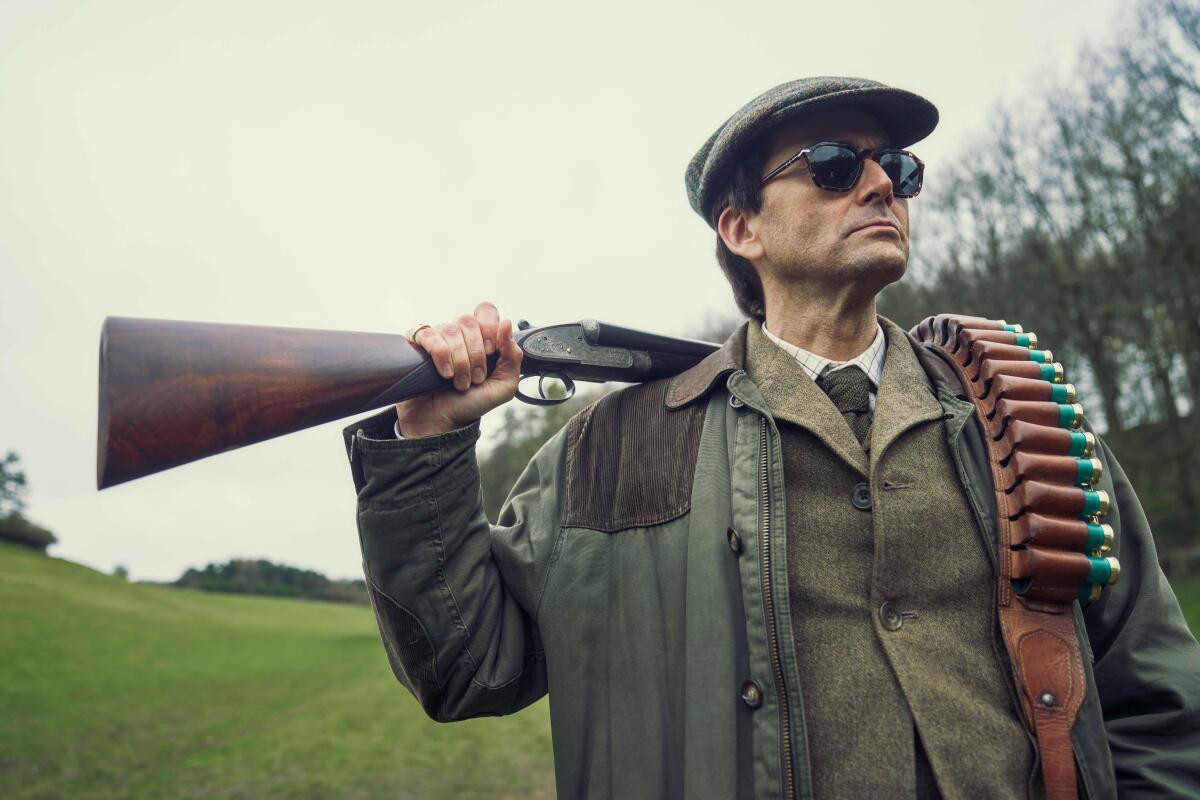
David Tennant in “Rivals.”
(Robert Viglasky / Disney)
“Rivals” (Hulu)
This rollicking social satire wrapped in a comic sex opera is set in 1986 among an incestuous group of wealthy neighbors and colleagues living adulterous and otherwise frisky lives in manor houses in the Cotswolds. Based on Jilly Cooper’s 1988 novel, the second of her Rutshire Chronicles, it plays like Evelyn Waugh with a lot more fornication. (A lot.) The eponymous rivals are David Tennant’s Lord Tony Baddingham, head of an independent television network, and Alex Hassell’s Rubert Campbell-Black — a champion equestrian serving as Margaret Thatcher’s Minister of Sport, whose naked rear end, in a bathroom on the Concorde, opens the series. Entering their treacherous world, along with his wife (Victoria Smurfit) and daughter (Bella Maclean), is hard-hitting TV journalist Declan O’Hara (Aidan Turner), lured from the upright BBC to Lord Tony’s fictional commercial network. With the divine Katherine Parkinson as a successful romance novelist not, one supposes, unlike Cooper, Claire Rushbrook as Lady Baddingham and Cameron Cook as an ambitious producer over from America, it’s a big bag of boiled sweets. — Robert Lloyd
Guest spot
A weekly chat with actors, writers, directors and more about what they’re working on — and what they’re watching
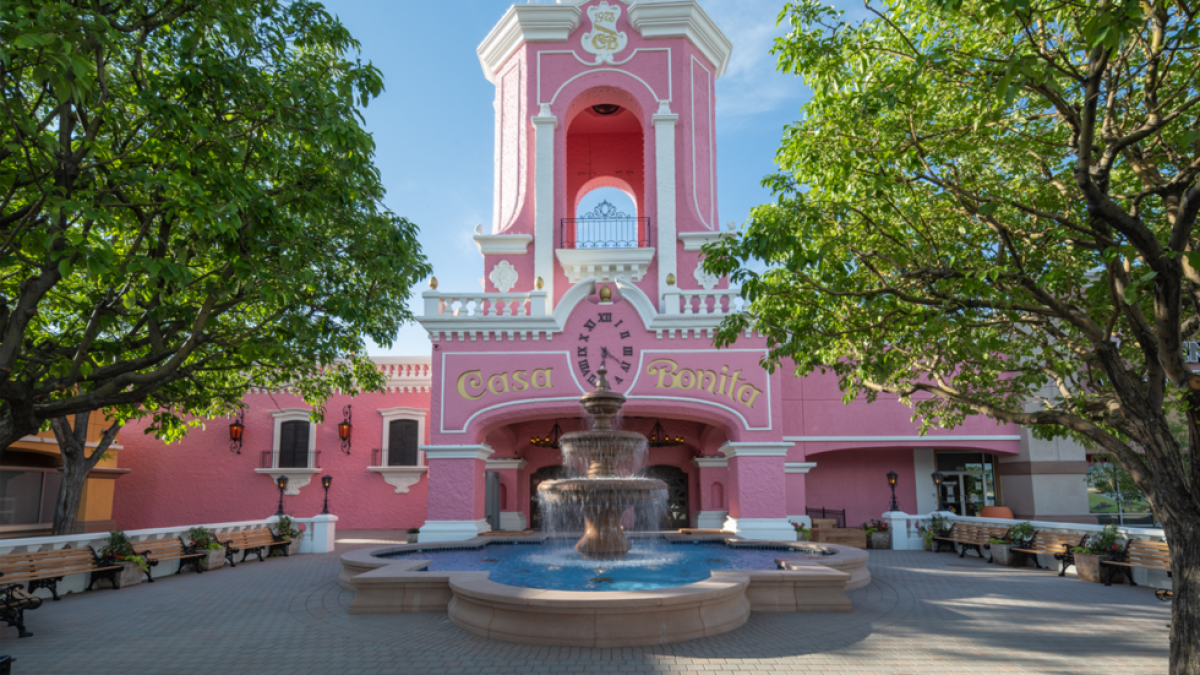
“Eatertainment” venue Casa Bonita, the setting and subject of the documentary “Casa Bonita Mi Amor!”
(MTV Documentary Films)
Those of us from outside Colorado didn’t know it at the time, but the 2003 “South Park” episode “Casa Bonita” — in which Kyle chooses Butters over Cartman for his birthday party at “the Disneyland of Mexican restaurants” and Cartman tries to bump Butters off the trip — wasn’t just an animated exaggeration of “eatertainment” stalwarts like Dave & Buster’s. Casa Bonita is not only a real restaurant in Lakewood, Colo., replete with cliff divers and haunted caves; it’s so beloved by “South Park” creators and Colorado natives Trey Parker and Matt Stone that they set out to save it when it looked like it might go under for good. Director Arthur Bradford was there to document the effort, resulting in the new film “Casa Bonita Mi Amor!,” now streaming on Paramount+. Bradford stopped by Screen Gab recently to reminisce about his first visit to Casa Bonita, what he’s watching and more. —Matt Brennan
What have you watched recently that you’re recommending to everyone you know?
I loved the documentary series “Love Has Won: The Cult of Mother God” [Max]. It’s such a weird and wild story and the filmmaker, Hannah Olsen, got incredible access. I loved the editing choices too, top notch. I also really liked Lucy Walker’s “Mountain Queen: The Summits of Lhakpa Sherpa” [Netflix]. I’ve been telling everybody to see that one because it’s about a lot more than climbing mountains.
What’s your go-to “comfort watch,” the film or TV show you return to again and again?
I’ve watched the HBO series “Succession” [Max] through multiple times and I keep finding new things to enjoy. I love the acting and the subtle humor. As far as documentaries, I’ve watched “American Movie” [Prime Video] six or seven times. The “Paradise Lost” trilogy [Max] and “Hoop Dreams” [Paramount+, Criterion Channel] are classics I love to revisit because they are such inspiring pieces of filmmaking.
Tell me about your first visit to Casa Bonita. What were your impressions?
I first went to Casa Bonita in 2012 when Matt and Trey took the cast of “Book of Mormon” there. We were actually filming that night and those are the scenes that open “Casa Bonita Mi Amor!” Matt and Trey had this infectious enthusiasm about the place. It was funny because part of their excitement was based on this idea that they’d reached a level of success where they could rent out their favorite childhood restaurant for the evening. Little did we know what would happen years later! I recall thinking the place was pretty run down. The smell of chlorine was overwhelming and yes, the food was terrible. But it was a fun time, especially because of how giddy Matt and Trey were about the whole thing.
Casa Bonita, like Rainforest Cafe, Planet Hollywood, Chuck E. Cheese, etc. is part of a dying breed of once-popular establishments combining food and entertainment. What about today’s cultural/economic landscape do you think most threatens them, and why do you think they’re worth saving?
Personally, I think Casa Bonita stands out among “eatertainment” venues. Chuck E. Cheese and Planet Hollywood have probably had their days in the sun. Casa Bonita stands out to me because it’s so weird and whimsical, and there’s only one left. Matt and Trey brought it into this day and age by embracing its handmade roots and paying attention to details. It doesn’t feel like corporate entertainment. Americans are always looking for fun group experiences, places where we can party together with family and friends and the best places for that are the ones which were created with true passion, like Casa Bonita.
Break down
Times staffers chew on the pop culture of the moment — love it, hate it or somewhere in between
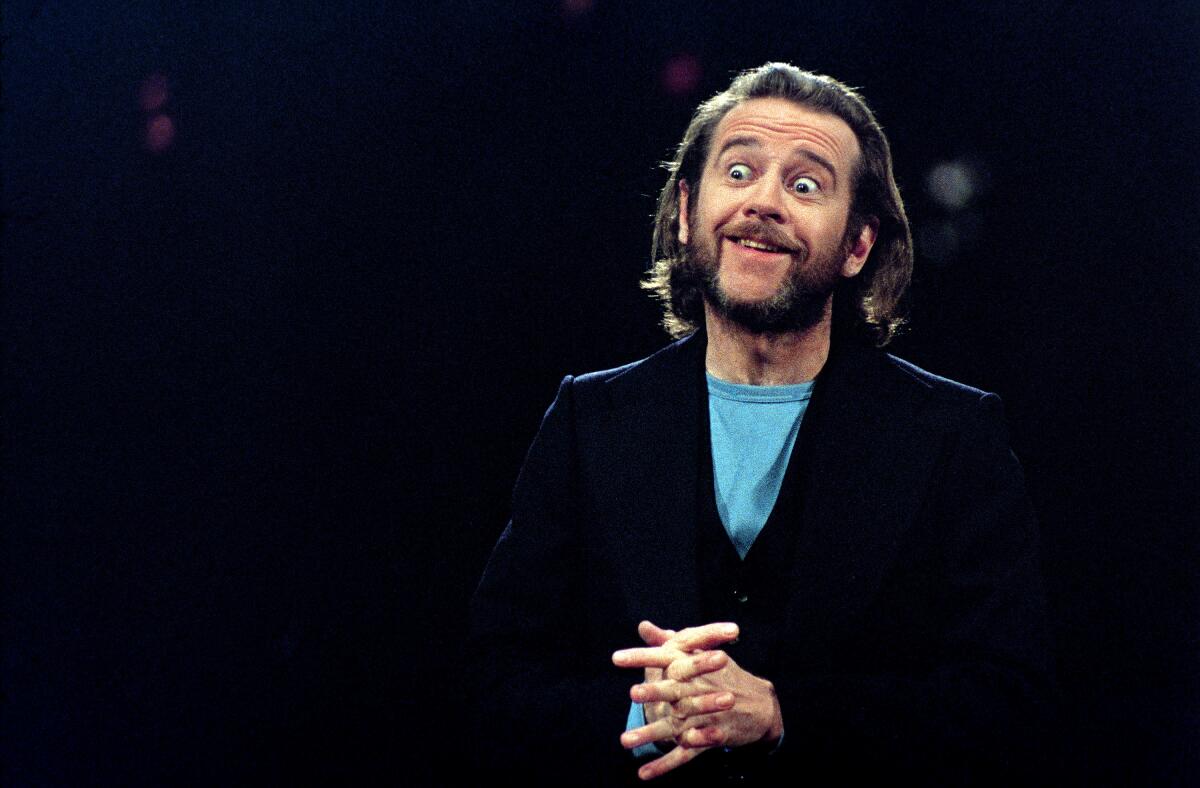
Host George Carlin during the monologue in the 1975 series premiere of “Saturday Night Live.”
(Herb Ball / NBCUniversal via Getty Images)
If the release of Jason Reitman’s new film “Saturday Night” has you curious about the very first episode of “Saturday Night Live,” you don’t have to look far: Thanks to Peacock, you can stream it in its entirety, along with the rest of the series’ 50 seasons to date. For all the film’s fealty to the facts, however, diving into the actual premiere reveals a show with a decidedly different vibe than either the frenetic pacing of “Saturday Night” or the more polished “SNL” of the present day. Longtime viewers and Times staffers Matt Brennan and Meredith Blake dug into the original artifact to break down where it succeeds, where it falls short and what today’s “SNL” could learn from it.
READ MORE: What was the first episode of ‘SNL’ really like? Fact vs. fiction in ‘Saturday Night’
Matt Brennan: Watching the Oct. 11, 1975, series premiere of “Saturday Night Live” after seeing “Saturday Night’s” dramatization of its making reminded me of toggling between original and retouched photographs: From a distance, Jason Reitman’s film version looks like a fair approximation of that first episode, but on closer examination it is very much the product of 50 seasons of mythmaking about the NBC sketch comedy show. For one, it foregrounds the cast of Not Ready for Prime Time Players — Dan Aykroyd, John Belushi, Chevy Chase, Jane Curtin, Garrett Morris, Laraine Newman and Gilda Radner — who’ve since become legends in their own right, even though they receive fifth billing in the opening credits — behind not only host George Carlin and musical guests Billy Preston and Janis Ian, but also “a film by Albert Brooks” and “Jim Henson’s Muppets.” “Saturday Night,” with 49 years of hindsight, treats the series as a classic-in-the-making, but it’s clear that those involved in the creation of “SNL” didn’t quite know what they had.
Meredith, you were the one who suggested I chase the movie with the actual episode it depicts, so I’m curious. What struck you most about how the show differs from what’s in the film, or the “SNL” we’ve come to know since?
Meredith Blake: The premiere episode has what I can only describe as “first pancake” energy. It’s messy and misshapen, and the recipe needs a major overhaul. With two musical guests, performances by comedians Andy Kaufman and Valri Bromfeld, and three stand-up sets by Carlin, plus the aforementioned Muppets and short flim by Brooks, the episode is a real hodgepodge — a variety show in the truest, most chaotic sense of the word.
As you pointed out, Matt, the soon-to-be-legndary cast is presented as something of an afterthought, and they get relatively little screen time. But they manage to show flashes of the greatness to come. Most of the sketches are short, even by contemporary standards — 2-3 minutes long — and are absurdist in a way that feels rather dated. The famous cold open features Belushi as an immigrant learning bizarre English phrases like “I would like to feed your fingertips to the wolverines” from a teacher played by head writer Michael O’Donogue, who keels over and dies, prompting Belushi’s character to do the same. There’s little of the topical or character-based comedy that would come to define “SNL,” but there are several commercial parodies, which remain a fixture on the show five decades later. (There’s even a fake ad for a razor with — would you believe it? — three blades, which is presented as a patently ludicrous idea.)
So much of comedy is about context, and most of what’s in this episode doesn’t really land in 2024. That’s not a bad thing: bits about a talk show hosted by Charli XCX will probably confuse viewers in 2074, if humanity makes it until then, I did laugh a few times, especially in a sketch where Aykroyd plays the head of a security system company who breaks into a couple’s home, terrifying them, then tries to sell them his products — a gag that felt more sharply critical of American culture than Carlin’s lightweight opening monologue about football versus baseball. But the most pointed, prescient moment is a pre-taped segment featuring a truck with a giant sign reading “Show us your guns!” As it winds through suburban streets, everyday Americans gleefully brandish their rifles and pistols. If it weren’t for the bell-bottoms, it might as well be 2024.
Matt, what aspects of the episode worked for you? What fell flat?
Brennan: I had seen enough clips from the early years to be prepared for skits like “Bee Hospital,” in which a nurse greets waiting-room papas (all in bee costumes) with new baby queens, workers and drones — comedy more reminiscent of a head-scratching New Yorker cartoon than “Celebrity Jeopardy!” I was less ready to see Carlin bomb so badly, though: At one point, during a riff on why there are so few blue foods, he rather desperately asked the audience, “Have I done these jokes before tonight?”
What struck me most might have been the sense that creator Lorne Michaels and Co., in shaping that first pancake of a pilot into the series we know and love (or love to hate), ended up making a string of smart editorial decisions. The expectation that hosts will participate in the sketches after an opening monologue has saved countless guests from flailing like Carlin did. (Though not all of them.) The tradition of live musical performances that deliver a jolt of emotion might be said to descend from Ian’s goosebump-raising numbers in the premiere. And “Weekend Update,” anchored by Chevy Chase and featuring a hilarious shot-chaser gag about a New York murder hotel with correspondent Laraine Newman, emerges fully formed as “SNL’s” test kitchen, a place for iconic one-liners, characters and personalities that can’t quite fit anywhere else.
My only complaint is that today’s version of the series has fewer and fewer of those oddball or off-kilter interludes. When we asked celebrities and readers recently to name their favorite “SNL” sketch of all time, vanishingly few chose topical material — the sort of stuff that, in recent years, has been relegated to second-half experiments from the likes of cast members Kyle Mooney and Bowen Yang. My main response to the premiere might well be “Make ‘SNL’ weird again!”
Are there any lessons you think the show’s current writers and cast members could benefit from learning from the Wild West of 1975?
Blake: Agree with you that the Carlin material is… not great. Or at least very different than what I expected, given his reputation as a counterculture icon. This felt about as risqué as Jerry Seinfeld, but maybe the NBC executives got to him? And you are right that the show could stand to get weird again. When I think about it, the moments that have really broken out in recent years — Yang as the iceberg that sank the Titanic, the Beavis and Butthead sketch, Ryan Gosling as the guy who invented the Papyrus font — have a certain weirdness to them. They’re playful, absurd, and connected to pop culture without being topical or insidery. (For what it’s worth, they also tend to feature Gosling, who should really get an annual slot as host.)
I think the most salient lesson, for all of us, is that “SNL” has always been uneven — and churned out some real duds even during its original heyday. No show, even a great one, is going to have a perfect batting average, and while you hope to make people laugh sometimes you may just leave them wondering if they missed the joke. As I think about my own relationship with “SNL” over the years, I’m also realizing something counter-intuitive. I first became acquainted with the show through prime-time clip specials on NBC, edited reruns on Nick at Nite and a VHS copy of “The Best of Gilda Radner” that my friend Missy owned. Then I started watching — or, rather, taping it — on my own.
Much has been made about how time-shifted viewing has affected late-night shows, which are increasingly consumed in bite-sized clips on social media instead of being watched in real time. Yet “SNL” has been around for so long that most of us actually discovered it in bits and pieces — we saw the greatest hits, and never had to sit through the filler sketches that aired at 12:52 a.m. back when Gerald Ford was president. Streaming allows us to enjoy the show in its original, unabridged form, where the magic comes with a side of “meh.”
